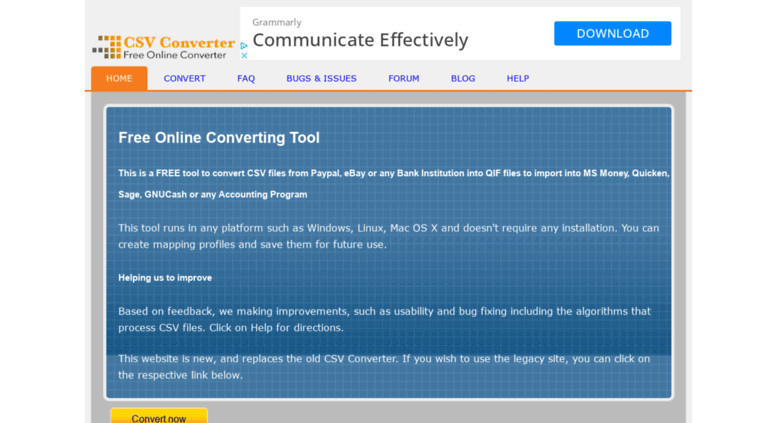

Read input from stdin cat file.csv | csv2ofx Print output to stdout csv2ofx ~/Downloads/transactions.csv d, -debug display the options and arguments passed to the parser OFX server date (default: source file mtime ) o, -overwrite overwrite destination file if it exists q, -qif enables 'QIF' output instead of 'OFX' L, -list-mappings list the available mappings Number of initial cols to skip (default: 0 ) The final rows to process, negative values count from the end (default: inf )

Number of initial rows to skip (default: 0 ) Number of rows to process at a time (default: 2 ** 14 ) 01/05/09 ) as the dayįield used to combine transactions within a split for double entry statements y, -dayfirst interpret the first value in ambiguous dates (e.g.

h, -help show this help message and exitĭefault account type 'CHECKING' for OFX and 'Bank' for QIF. Source the source csv file (defaults to stdin )ĭest the output file (defaults to stdout ) chain () for line in IterStringIO ( content ): print ( line ) CLI Examplesĭescription: csv2ofx converts a csv file to ofx and qif gen_trxns ( groups ) cleaned_trxns = qif. Normal QIF usage import itertools as it from tabutils.io import read_csv, IterStringIO from csv2ofx import utils from csv2ofx.qif import QIF from import mapping qif = QIF ( mapping ) records = read_csv ( 'path/to/file.csv', has_header = True ) groups = qif. chain () for line in IterStringIO ( content ): print ( line ) gen_trxns ( groups ) cleaned_trxns = ofx. Normal OFX usage import itertools as it from meza.io import read_csv, IterStringIO from csv2ofx import utils from csv2ofx.ofx import OFX from import mapping ofx = OFX ( mapping ) records = read_csv ( 'path/to/file.csv', has_header = True ) groups = ofx. INSTALLATIONĬsv2ofx is intended to be used either directly from Python or from the command line. RequirementsĬsv2ofx has been tested and is known to work on Python 3.7, 3.8, and 3.9 and PyP圓.7. csv2ofx has built in support for importing csv files from mint, yoodlee, and xero. We have not come across any issues throughout our evaluation, since CSV2QFX Converter did not hang or crash.Īll in all, CSV2QFX Converter delivers a simple solution to turning CSV files into QFX to be edited in Quicken.Csv2ofx is a Python library and command line interface program that converts CSV files to OFX and QIF files for importing into GnuCash or similar financial accounting programs.

The app carries out conversion very quickly and without error, while using low CPU and RAM, so the computer's overall performance is not affected. In addition, you can preview CSV files, save log details to file for closer inspection, ask the app to read dates in either US or Euro format, as well as edit Quicken account information when it comes to the account type, Quicken financial institution, bank routing number, and account number in Quicken. The interface is represented by a normal window with a plain and simple structure, where you can open a CSV file using the file browser only, since the drag-and-drop method is not supported.
#Csv2qfx free portable#
There is also the possibility of saving Portable CSV2QFX Converter to a USB flash disk or other mass storage device, in order to run it on any PC with minimum effort, as long as it has Java installed.Īn important aspect to take into account is that no new entries are created in the Windows registry or Start menu, leaving the disk clean after removal. You can put the JAR file anywhere on the hard disk and just click it to run. It comes bundled with a standard set of options that can be easily tweaked by all user levels, even the ones with no prior experience in computer software.īased on Java, installation is not a prerequisite in case of this tool.
#Csv2qfx free software#
Portable CSV2QFX Converter is a straightforward piece of software designed to easily transfer CSV transactions to QFX files, in order to edit them in Quicken.


 0 kommentar(er)
0 kommentar(er)
